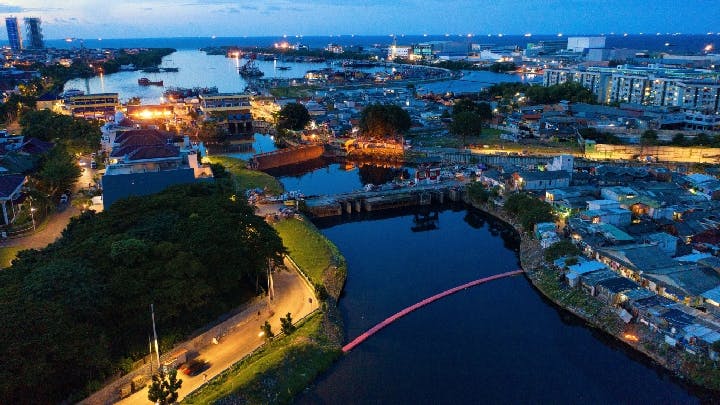Summer 2019
A Sinking Metropolis
– Jennifer Moeller-Gulland and J. Carl Ganter
A day in the life of Jakarta—a city drowning in water insecurity.
Ujang heaves his dilapidated wooden cart up the rough street through an afternoon downpour. The irony isn’t lost on him: While drenched to the skin, he’s delivering water to thirsty homes and bodegas in the slums of North Jakarta.
It takes every bit of his muscle to push the cart—and its nearly 1,000 pounds of water in blue plastic buckets—over a rise in the broken pavement.
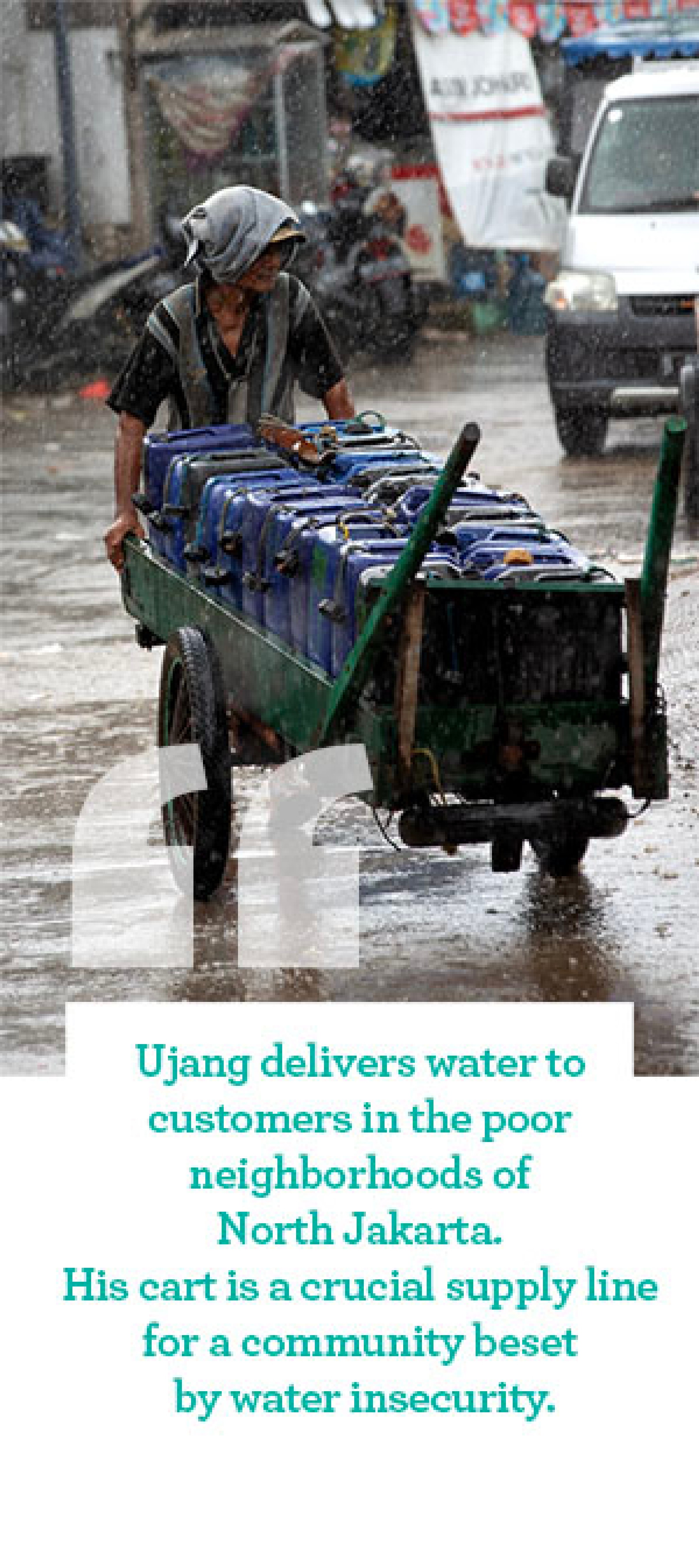
Ujang stops in front of a food stand, wipes the rain and sweat from his eyes, and hefts two of the containers to the sidewalk. Parina, the restaurant’s owner, has been waiting anxiously. It’s lunchtime, and without water, her kitchen grinds to a halt.
Parina, 46, is among the nearly 5 million Jakarta residents who rely on water deliveries daily. As a single mother of three children, she counted as luck that one of her neighbors had enough money to drill a small, undocumented well that now supplies about 100 members of her community for $14 a month.
But the makeshift well’s water has become oily. Last year she began to supplement her supply by paying $25 each month to Ujang to deliver 6,000 liters of water for drinking and cooking. In all, she pays him about 10 percent of her monthly income.
The water comes today, but Parina, her family, and her business are on the point of a precarious spiral for this city of some 10.5 million people: Jakarta is sinking, many neighborhoods are below sea level and battling floods, its groundwater sources are becoming harder to reach and more contaminated, and its rivers are fouled with garbage and raw sewage.
The day after we visited Parina’s neighborhood in May, president Joko “Jokowi” Widodo re-confirmed his intention to move Indonesia’s capital out of Jakarta. Politicians have threatened to move the nation's government elsewhere before, and they had plenty of reasons, from interminable traffic jams and air pollution, to a thin concrete wall that holds back the rising seas from inundating the city.
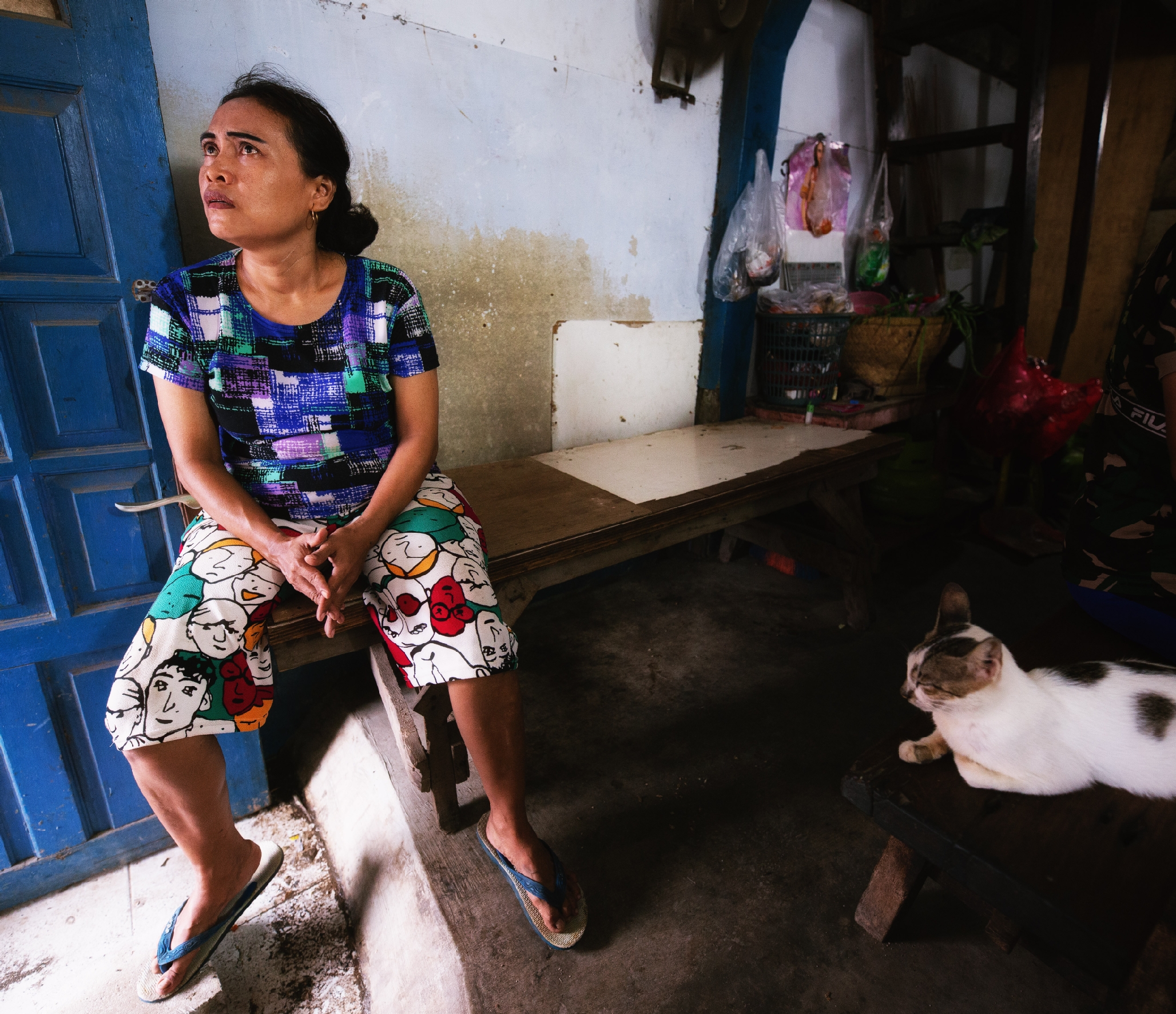
“Imagine a black swan event: a crack, a breakdown of the seawall in 10 to 20 years,” says Abedalrazq F. Khalil, a senior water resource management specialist of the World Bank Water Global Practice, based in Singapore. “By then subsidence would have sunk the city another meter. The resulting inundation would reach deep into the city. As a rough estimate, you would have three to four million people exposed to a three-meter wall of sea water. The impact on life and economy would be devastating.”
Only a few blocks away from Parina’s shop, Toyib taps on the ceramic tiles of his sparse home. He lifts a lid in his floor to show us his shallow well and the open-pit septic tank that is only three meters away. He’s head of the neighborhood and has access to the public water supply, but to save on his water bill, he uses this water from his own well for cleaning, washing clothes, and bathing.
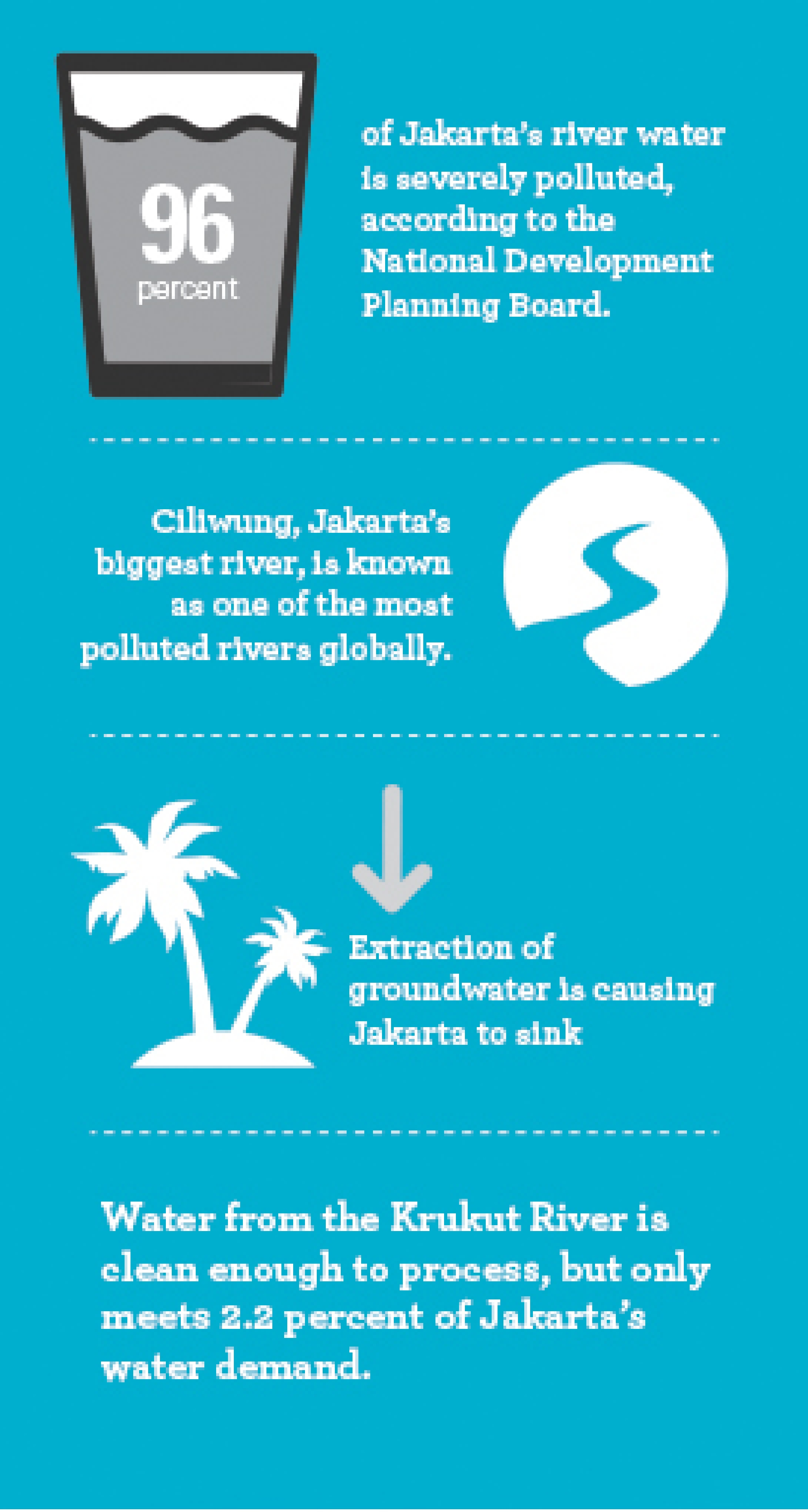
Many of the city’s poor neighborhoods like this one in North Jakarta have sewage tanks that are open in the bottom, letting the putrid liquid flow directly into the vulnerable aquifers below, and back into informal water wells like his. “Everyone has a septic tank designed to leak,” he said.
Driven either by lack of reliable water supplies from the utilities, or by the cost savings from these individual wells, the unregulated pumping is causing land subsidence and making Jakarta one of the world’s fastest sinking cities.
“One can’t reverse subsidence,” observes Khalil of the World Bank. “You can’t stabilize or slow it down. Experience from other cities show that it takes 10 to 20 years after all groundwater abstraction has been stopped for subsidence to stabilize. Actions are urgent and can’t be further delayed.”
With only 4 percent of Jakartans connected to the sewage network—the second lowest coverage of a capital in Southeast Asia—the majority of households like Toyib’s depend on pit latrines and makeshift septic tanks for sanitation.

In many parts of the world, microloans make getting water to homes affordable. In North Jakarta, water.org and others are using microcredit loans to make it affordable for residents to haul contaminated water away.
BMT Bus (Bina Ummat Sejahtera) is partially financed by water.org and offers small loans to empty overflowing septic tanks and install new ones.
“Credits are mostly taken to empty septic tanks which were blocked and thus overflowed – especially in the rainy season,” said Esti, a manager of BMT BUS North Jakarta and its water, sanitation and hygiene team. “Some families haven’t emptied their septic tanks in 20 years.”
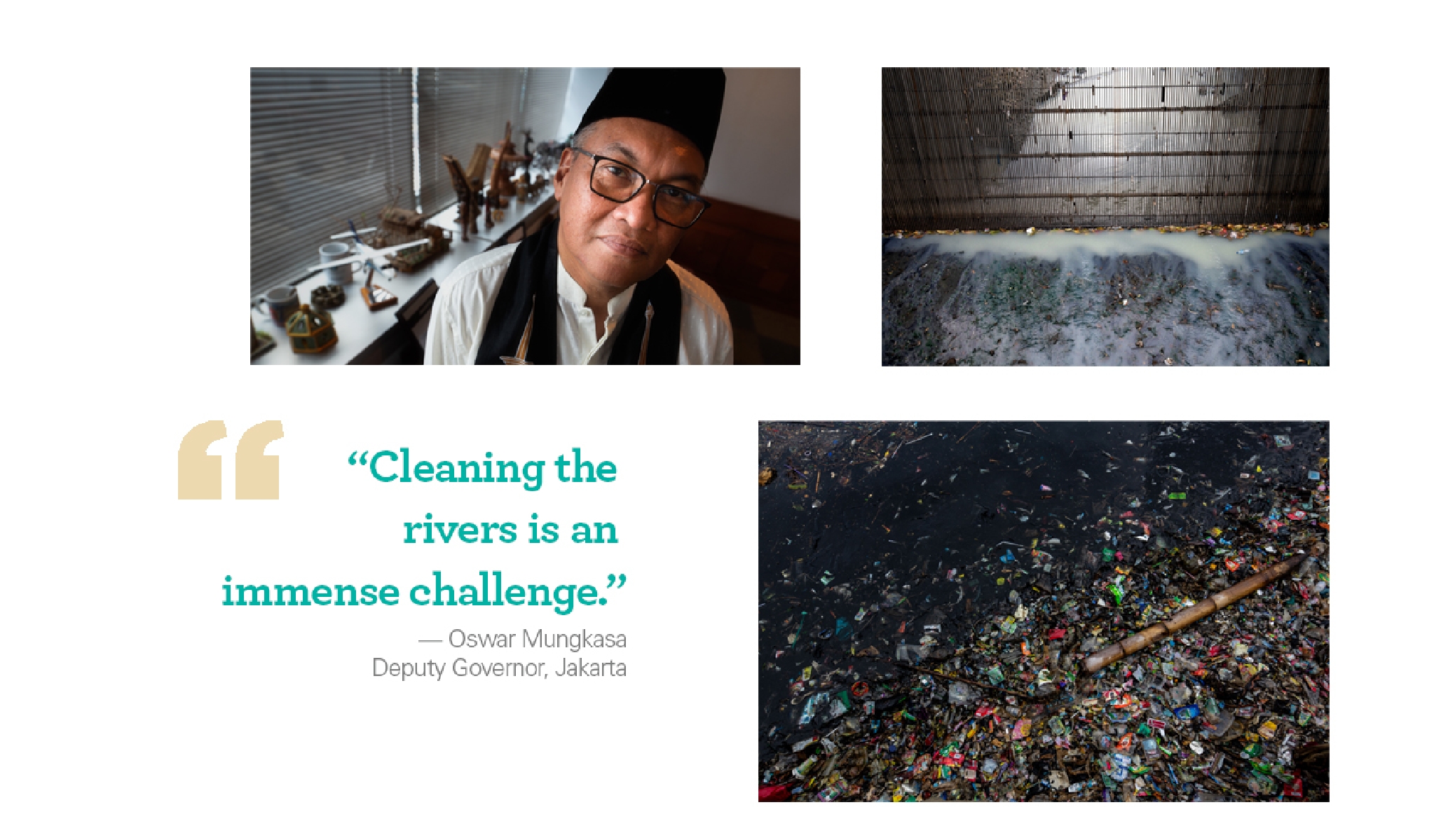
“There is no good solution for sanitation at the moment—we can only encourage people to get good and sealed septic tanks,” said Don Johnston of water.org. But even if there was a good answer for sanitation, homes and businesses would still have to discharge their graywater from cooking and cleaning directly into the city’s many small canals that flow reeking into the rivers and on to Jakarta Bay.
But even if the sewage and graywater stopped flowing tomorrow, the canals and rivers would still swell with garbage, said Professor Yusli Wardiatno of the IPB University in Bogor, who studies the effects of plastics in ecosystems and fisheries. “In the rainy season, you can see mattresses and refrigerators floating by.”
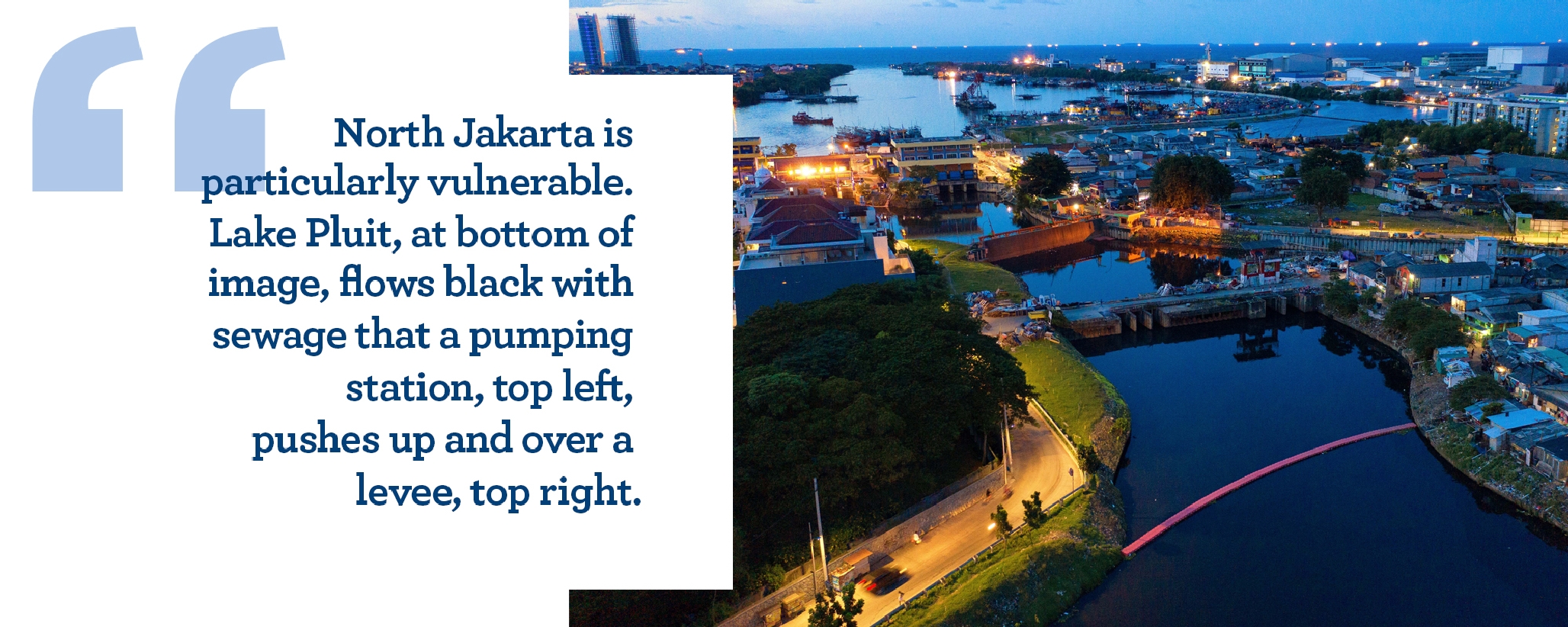
We stand in the shade of mangroves in the Muara Angke Wildlife Refugee and watch mats of plastic refuse drift down the river. The garbage accumulates along the banks of Jakarta’s 13 rivers. Professor Wardiatno scrapes at the mud, pointing to multicolored bits of plastic that reach up to three meters deep into the soil.
Oswar Mungkasa, Deputy Governor of Jakarta for Spatial Planning and Environment, is happy to meet in his downtown Jakarta office to talk about Jakarta’s water future. He is hopeful, but solving Jakartas’s profound water challenges could take years in the face of palpable urgency. If only the city could unite to clean the rivers and manage its sewage, he says, Jakarta could have a better prognosis.
“We are well aware of the potential the rivers have to address the vicious circle of over abstracting groundwater and consequent land subsidence—but cleaning the rivers is an immense challenge with many actors involved,” he said.
Bambang Harymurti, former editor in chief of Tempo, Indonesia’s leading weekly magazine, has spent his career writing about politics, human rights, and environmental justice and believes that Jakarta’s water story is the one that will define its future.
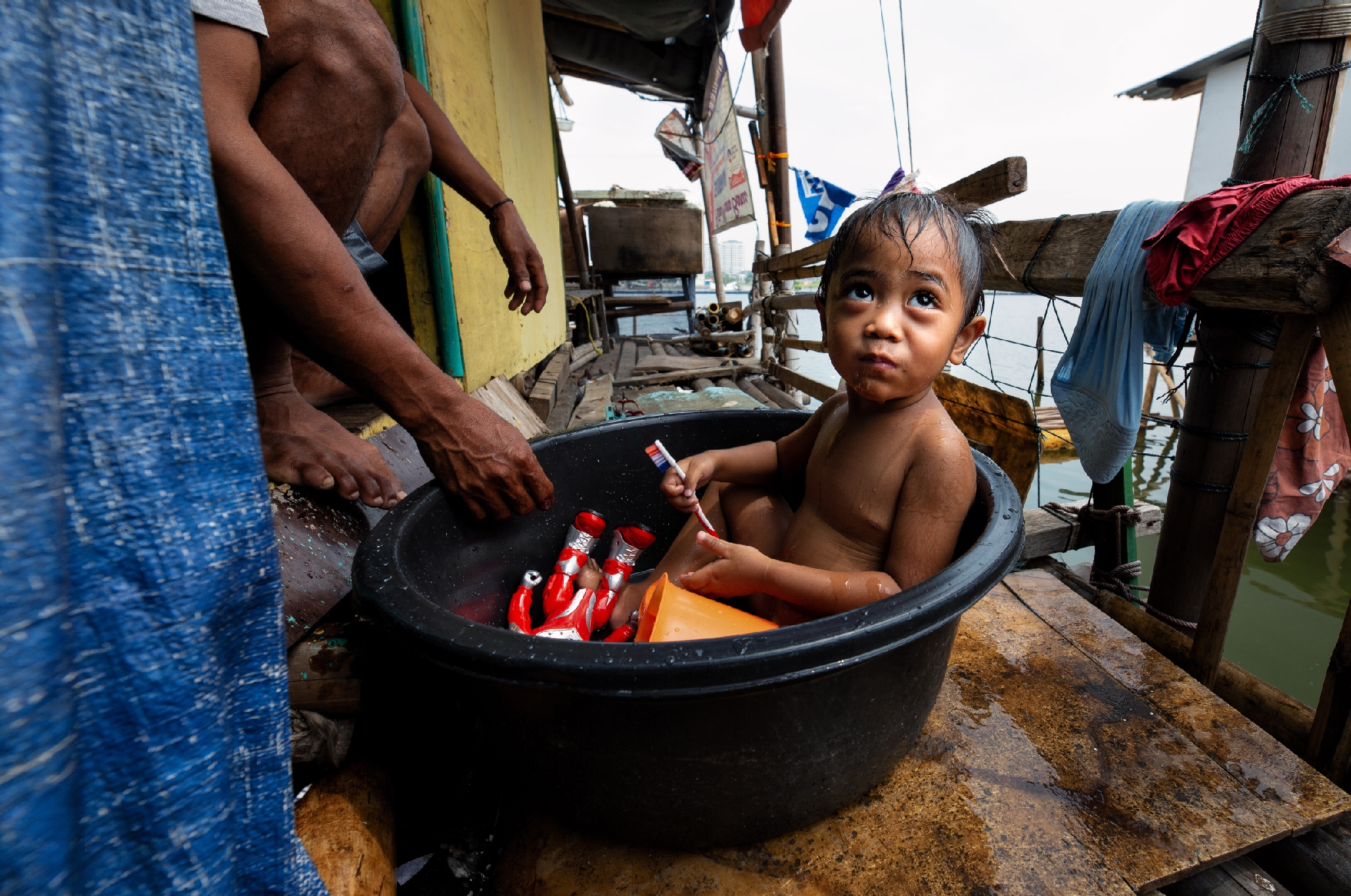
“There is hope, though,” he said. He points to Surabaya, Indonesia’s second largest city, where the mayor has successfully managed to deliver on a promise of 100-percent piped water coverage to its residents and where the rivers are increasingly becoming cleaner. “Responsibility now lies with Jakarta to learn from Surabaya and take action quickly.”
Back in North Jakarta, dusk settles over Lake Pluit and the light breeze barely causes a ripple over the dark water, thick with sludge. The nearby pumping station, with lights burning yellow against the night, is the rampart. The grey pumps inside, three times taller than the men who tend them, push the black, untreated wastewater up and over the thin levee that holds back the sea.
Jennifer Moeller-Gulland is the founder and managing director of Water Security Collective, a Dubai-based company focusing on water risk advisory and training. Over the past 13 years, Jennifer has focused on assessing water risks and identifying solutions for multiple countries in Asia, Africa, and the Middle East, as well as corporate production sites and supply chains. Clients include the World Bank, 2030 Water Resources Group, the UN and multi-national companies, and she collaborates with Circle of Blue to publish news articles. To train the next generation of water risk experts, Jennifer runs two trainings, the Water Risk Crash Course, and the 12 week in-depth and interactive Water Risk Assessment Blueprint Training. Jennifer was previously Manager at PwC and completed her bachelors of science in international economics and finance (cum laude) from Tilburg University and her masters in water science, policy, and management from Oxford University.
J. Carl Ganter (@circleofblue) is co-founder and managing director of Circle of Blue and Vector Center, which report on global resource issues, particularly the competition between water, food, and energy in a changing climate. He is a recipient of the Rockefeller Foundation Centennial Innovation Award and served as vice-chairman of the Global Agenda Council on Water Security at the World Economic Forum.
Opening video by Kathy Butterfield and J. Carl Ganter. All photos by J. Carl Ganter/circleofblue.org.
